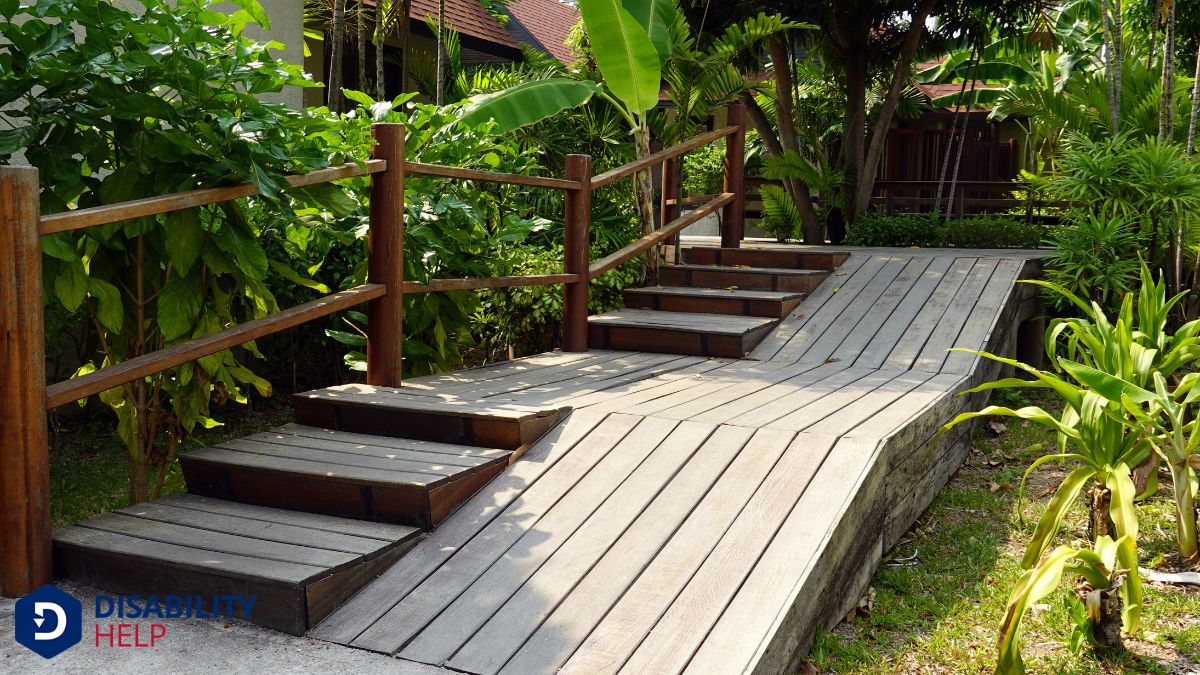When we're considering adding a ramp to our home, understanding the costs involved is essential. With various types, materials, and installation options available, prices can vary greatly. Whether we're looking at portable, permanent, or modular ramps, each choice comes with its own set of financial implications. But what exactly influences these costs, and are there ways to manage them effectively? Let's explore the factors that can impact our investment.
Key Takeaways
- Aluminum ramps cost between $100 - $200 per linear foot, offering lightweight and rust-resistant features.
- Wood ramps are affordable, ranging from $50 to $150 per linear foot, but require regular maintenance.
- Steel ramps are durable and handle heavy loads, priced at $150 to $250 per linear foot.
- Labor and installation costs depend on design complexity, materials, and local rates, affecting overall expenses.
- Permitting, compliance fees, and site preparation impact total ramp installation costs.
Types of Home Ramps

When considering home ramps, it's important to understand the different types available to suit various needs.
To begin with, we've portable ramps, which are lightweight and ideal for temporary use. They're easy to move and store, making them perfect for travel.
Permanent ramps, on the other hand, are fixed structures designed for long-term accessibilityThe design of products, devices, services, or environments to be usable by people with disabilities..... They provide a stable, reliable solution for homes with frequent wheelchair access needs.
Modular ramps offer another option. They're versatile, consisting of interchangeable parts that allow customization to fit different entryways and slopes.
Finally, threshold ramps help with small steps and doorways, providing a smooth changeover for wheelchairs and walkers.
Material Options and Their Costs
Selecting the right material for a home ramp is essential, as it directly influences both durability and cost.
Let's explore some common options. Aluminum ramps are lightweight, rust-resistant, and ideal for portability. They usually cost between $100 to $200 per linear foot, depending on features.
Wood ramps offer a classic look and can be more affordable initially, between $50 to $150 per linear foot, but they require regular maintenance to prevent rot and wear.
Steel ramps are incredibly durable, handling heavy loads with ease, but they're pricier, ranging from $150 to $250 per linear foot.
Finally, composite materials offer a balance of durability and aesthetics, typically costing $100 to $200 per linear foot.
Each material has its strengths, so it's important to evaluate our specific needs and budget.
Labor and Installation Expenses
Now that we've looked at material costs, let's consider the expenses involved in labor and installation.
Hiring a professional can vary in cost depending on their rates and our location, while opting for a DIY approach might save money but could require more effort and skill.
It's important to weigh these options and understand how regional differences might affect our overall budget.
Professional Installation Rates
Considering the various factors that influence professional installation rates, it’s essential to understand the elements that contribute to the overall cost.
First, the complexity of the ramp design can greatly impact labor expenses. A simple, straight ramp often costs less to install than one with curves or switchbacks.
Second, the materials we choose, such as wood, aluminum, or concrete, affect both labor intensity and installation time.
Additionally, local labor rates vary based on geographic location, which can lead to differences in total costs.
Finally, the site’s condition and accessibility play a role; a clear, level area is typically cheaper to work with than a sloped or obstructed space.
DIY vs. Hiring Costs
While weighing the options between DIY and hiring a professional for ramp installation, it’s crucial to evaluate both the financial and practical implications.
If we decide to tackle the project ourselves, we might save on labor costs, which can range from $500 to $1,000 or more, depending on the complexity. However, we should consider our skill level and available time. A poorly constructed ramp can pose safety risks.
On the other hand, hiring a professional increases upfront expenses but guarantees proper installation. Professionals bring expertise and tools, delivering a durable ramp with less hassle.
We should remember that improper installation might lead to additional costs down the road. Ultimately, our decision should balance budget constraints, skill confidence, and the importance of safety.
Regional Labor Variations
When planning to install a home ramp, we must consider how regional labor variations can greatly impact our budget. Labor costs fluctuate considerably across different areas, influenced by local economy, demand, and availability of skilled workers.
In some regions, the abundance of contractors might lower prices, while in others, a shortage can drive costs up. Additionally, urban areas often have higher labor rates compared to rural ones due to higher living costs.
To anticipate expenses accurately, we should research local contractor rates and compare multiple quotes. It's essential to understand that these variations aren't just about price. The quality of work and availability can also differ, affecting our project's timeline and outcome.
Customization Considerations
When we think about customizing a home ramp, we must consider how the material choice impacts cost and durability.
The ramp's length and slope not only affect its usability but also its overall price.
Additionally, selecting the right safety features guarantees accessibility and security, making our investment worthwhile.
Material Choice Impact
Choosing the right material for a home ramp greatly affects both its cost and functionality.
As we explore options, understanding each material's impact helps us make an informed decision. Here are four common materials to evaluate:
- Wood: Often the most affordable, wood provides a natural look but may require regular maintenance to combat weathering and rot.
- Aluminum: Lightweight and rust-resistant, aluminum ramps offer durability with minimal upkeep, though they might come with a higher initial price.
- Steel: Known for its strength, steel can support heavier loads but requires rust protection, making it a robust yet potentially costly choice.
- Concrete: Offers exceptional durability and stability, ideal for permanent installations, though installation costs can be significant.
Each material has its pros and cons, shaping our ramp's functionality and budget.
Length and Slope
As we assess materials for our home ramp, it's equally important to contemplate its length and slope. These factors are essential for guaranteeing the ramp is both functional and accessible.
The length of a ramp directly affects its slope, which determines how easy it is to navigate. A gentler slope requires a longer ramp, which might increase costs but guarantees comfort and safety, particularly for wheelchair users.
Common guidelines suggest a 1:12 slope ratio, meaning one foot of ramp for every inch of rise. However, this can vary based on specific needs and available space.
Safety Features Options
To guarantee our home ramp is as safe as it is functional, we should explore various safety feature options available for customization.
We need to prioritize features that enhance usability and minimize risks. Here's a brief list of considerations:
- Non-Slip Surface: Secures traction, especially during wet conditions, reducing the risk of slips and falls.
- Handrails: Essential for balance and support, especially for individuals with limited mobility or those using wheelchairs.
- Edge Protection: Prevents wheels from slipping off the sides, offering an extra layer of safety.
- Adequate Lighting: Improves visibility during nighttime, making sure users can clearly see the ramp's path.
Permitting and Compliance Fees
When planning to install a home ramp, we must consider not just the construction costs but also the permitting and compliance fees.
These fees vary depending on local regulations, and it’s important to check with our local government or building authority. Permits guarantee our ramp meets safety and accessibility standards, which can prevent legal issues down the line.
We might need to pay for inspections or specific compliance checks, guaranteeing the ramp aligns with codes such as the Americans with Disabilities Act (ADA)A U.S. law that prohibits discrimination against individuals with disabilities in all areas of publi....
While this might seem cumbersome, adhering to these requirements guarantees everyone’s safety and accessibility.
It’s wise to budget for these fees upfront, as they’re a vital part of the overall ramp installation process.
Size and Slope Specifications
Designing a home ramp involves careful consideration of its size and slope specifications to ensure it’s both safe and accessible.
We must focus on specific factors to guarantee the ramp meets our needs and adheres to regulations. Here's what we should consider:
- Slope Ratio: A common guideline is a 1:12 slope ratio, meaning for every inch of height, there should be at least 12 inches of ramp length.
- Width: The minimum recommended width is 36 inches, providing enough space for wheelchair passage.
- Landing Areas: At the top and bottom of the ramp, landing areas should be at least as wide as the ramp and 60 inches long.
- Handrails: If the ramp rises more than 6 inches, handrails are typically required for safety.
These elements help us create an effective home ramp.
Location and Site Preparation
After considering the size and slope specifications for our home ramp, we should focus on its location and site preparation.
First, let's choose a spot that's convenient and accessible, ideally close to the entrance. This guarantees ease of use and safety.
Once we've identified the location, we need to assess the terrain. Is the ground level, or does it require grading? Uneven surfaces might need additional work to guarantee a stable foundation.
Next, we'll need to clear the area of any obstacles like rocks, plants, or debris. This step is vital for safety and stability.
Finally, consider potential drainage issues. We want to prevent water accumulation, which could damage the ramp over time. Proper preparation now will save us trouble later.
Maintenance and Longevity
When considering the cost of a home ramp, we must think about maintenance and longevity.
Regular cleaning is essential to prevent buildup that can damage the ramp over time.
Let's also consider the durability of materials and how seasonal weather can affect them, ensuring our investment lasts as long as possible.
Regular Cleaning Importance
Although we often focus on the installation costs of a home ramp, regular cleaning is just as essential for maintaining its longevity and functionality.
By keeping our ramps clean, we prevent build-ups that can lead to damage or accidents. Here’s how regular cleaning benefits us:
- Prevents Slips and Falls: Dirt and debris can make ramps slippery. Cleaning guarantees a safe, non-slip surface.
- Reduces Wear and Tear: Regular removal of grime prevents erosion and extends the ramp’s life.
- Keeps It Attractive: A clean ramp looks inviting and well-maintained, enhancing our home’s curb appeal.
- Identifies Issues Early: While cleaning, we might notice small problems that need fixing before they become costly repairs.
Let’s make cleaning a habit to guarantee our ramp serves us well.
Material Durability Factors
While regular cleaning plays a significant role in maintaining our home ramps, the materials used in their construction equally impact their durability and longevity.
Choosing between wood, aluminum, steel, or concrete affects not only the lifespan but also the maintenance required for our ramps. Each material has its pros and cons; for instance, wood offers aesthetic appeal but needs regular sealing to prevent rot.
Aluminum is lightweight and corrosion-resistant, requiring minimal upkeep. Steel is sturdy but can rust without proper coating. Concrete provides durability but may crack over time.
Understanding these factors helps us select the right material that balances cost and maintenance. In doing so, we guarantee our ramps serve us well for years with minimal fuss.
Seasonal Weather Effects
As we consider the impact of seasonal weather on our home ramps, it’s crucial to acknowledge how different climates can affect their maintenance and longevity.
Weather changes can greatly influence the materials' durability, and understanding these effects helps us make informed decisions.
Here's how various conditions might impact our ramps:
- Rain and Humidity: Moist climates can cause wood to rot and metal to rust, requiring regular sealing or painting.
- Snow and Ice: Accumulation creates slippery surfaces, demanding frequent clearing and possibly adding non-slip materials.
- Sun Exposure: Prolonged UV exposure can degrade materials, leading to fading and weakening, necessitating protective coatings.
- Temperature Fluctuations: Extreme temperatures can lead to expansion and contraction, causing cracks or warping over time.
Potential Cost-Saving Strategies
To make home ramp installations more affordable, we can explore several cost-saving strategies that won't compromise quality or safety.
First, consider using modular ramp systems. These pre-fabricated ramps are often less expensive than custom-built options and can be easily adjusted or relocated as needed.
Next, sourcing materials locally can reduce transportation costs and support local businesses. We can also look for second-hand materials or gently used ramps that meet safety standards, which might be available through community groups or online marketplaces.
Additionally, tackling the installation ourselves, if we're handy with tools, can eliminate labor costs. However, it's essential to guarantee we follow all safety guidelines and local regulations.
Every small saving can add up, making the overall expense more manageable.
Financing and Assistance Programs

Maneuvering the financial aspect of installing a home ramp can be intimidating, but multiple financing and assistance programs are available to ease the burden.
Let’s explore some options together:
1. MedicareA U.S. federal health insurance program for people aged 65 and older, and for some younger people wi... or MedicaidA U.S. government program that provides health coverage to eligible low-income individuals, includin...: These programs might cover some ramp costs if they deem the ramp medically necessary.
Let's check their eligibility criteria.
2. Veterans Affairs (VA)A U.S. government agency that provides services and benefits to military veterans, including those w... Benefits: If we're veterans, the VA may offer grants for home modifications, including ramps.
3. Nonprofit Organizations: Groups like Rebuilding Together or Habitat for Humanity sometimes provide assistance or reduced-cost services.
4. State and Local Programs: Many states have specific funding options for accessibility improvements.
Researching our local area can reveal available grants or loans.
Conclusion
In considering the investment in a home ramp, we should weigh the type, material, and installation needs. While portable and wood ramps might save initial costs, permanent or modular options offer durability. Don't forget labor, permits, and customization can add up. Let's explore cost-saving strategies and financing or assistance programs to ease the financial burden. Ultimately, a well-chosen ramp enhances accessibility and safety, benefiting us all in the long run.






